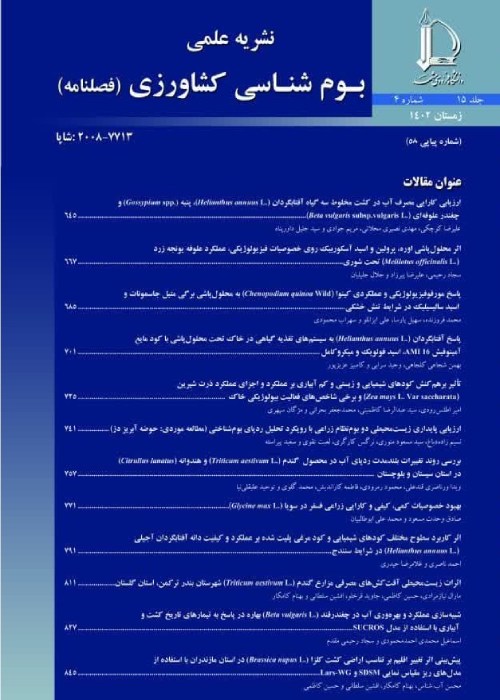Zoning and Evaluation of Carbon Sequestration Potential, Primary Net Production and Carbon Allocation Coefficients of Soybean (Glycine max L.) in Gorgan Township
Introduction:
Climate change and global warming are the most important challenges in sustainable development, which is due to increased concentration of greenhouse gases in the atmosphere. Carbon dioxide is a major component of greenhouse gases. In order to reduce atmospheric carbon dioxide and to create a balance in the content of greenhouse gases, atmospheric carbon must be absorbed in organic forms (Dieleman et al., 2015; Lichtfouse, 2009). For this aim, a study was done in agricultural lands of Gorgan in order to estimate the carbon sequestration potential of soybean plant (Glycine max L.).
This research was carried out in 150 soybean fields of Gorgan township and sampled by quadrate 0.5Í0.5 m2 as random method, during 2016-2017. The soybean shoot and root organs were individually harvested and transferred to the laboratory. An electric burn furnace method was used to determine the carbon sequestration potential in soybean organs (including pods, seeds, stems, leaves and roots). Also, the amount of shoot to root and harvest index were estimated to determine the net primary production based on carbon content in the above ground organ, below ground organ and total plant, and the carbon allocation coefficients in each soybean organ. Then, using different interpolation methods, the spatial distribution of carbon sequestration of the plant organs was investigated in ArcGIS software. All data were analyzed by SPSS software.
The results showed that Kriging method was the best model for carbon interpolation and distribution of carbon sequestration potential in agricultural lands of Gorgan township. The amount of stored carbon was obtained as 579.64 kg.ha-1 in leaves, 744.81 kg.ha-1 in stem, 881.16 kg.ha-1 in seeds, 340.16 kg.ha-1 in pods and 540.21 kg.ha-1 in root. Also, according to harvest index (32%) and grain yield (3461.13 kg.ha-1), other indexes were calculates as the ratio of shoot to root about 4.30, the total net primary carbon production 6734.8 kg.ha-1, above-ground net primary carbon production 4867.2 kg.ha-1 and below-ground net primary carbon production about 1867.63 kg.ha-1. Also, the shares of the allocation coefficients of economic organs, stems, leaves, root and root secretions were 0.23, 0.49, 0.61 and 0.12, respectively. The zoning results showed that the total stored carbon potential in soybean plant was highest in the eastern, north and southeastern regions of the surveyed area, and the central, western and southwestern parts of this township had the lowest stored carbon potential. Also, the amount of carbon sequestration potential (total above ground and below ground organs) was as 3085.98 kg.ha-1 in this study.
The highest proportion of carbon was allocated to the shoot organs, and the carbon of root exudates was also lower than other plant organs. In this study, it has been found that the potential of carbon sequestration was different in soybean plant organs and some variable such as agronomical management, soil and climatic condition can affect on its contents.AcknowledgementsWe are thankful to Gorgan University of Agricultural Sciences and Natural Resources (GUASNR), Agriculture Services Centers of Gorgan and soybean farmers for all their companions and supports.
- حق عضویت دریافتی صرف حمایت از نشریات عضو و نگهداری، تکمیل و توسعه مگیران میشود.
- پرداخت حق اشتراک و دانلود مقالات اجازه بازنشر آن در سایر رسانههای چاپی و دیجیتال را به کاربر نمیدهد.



